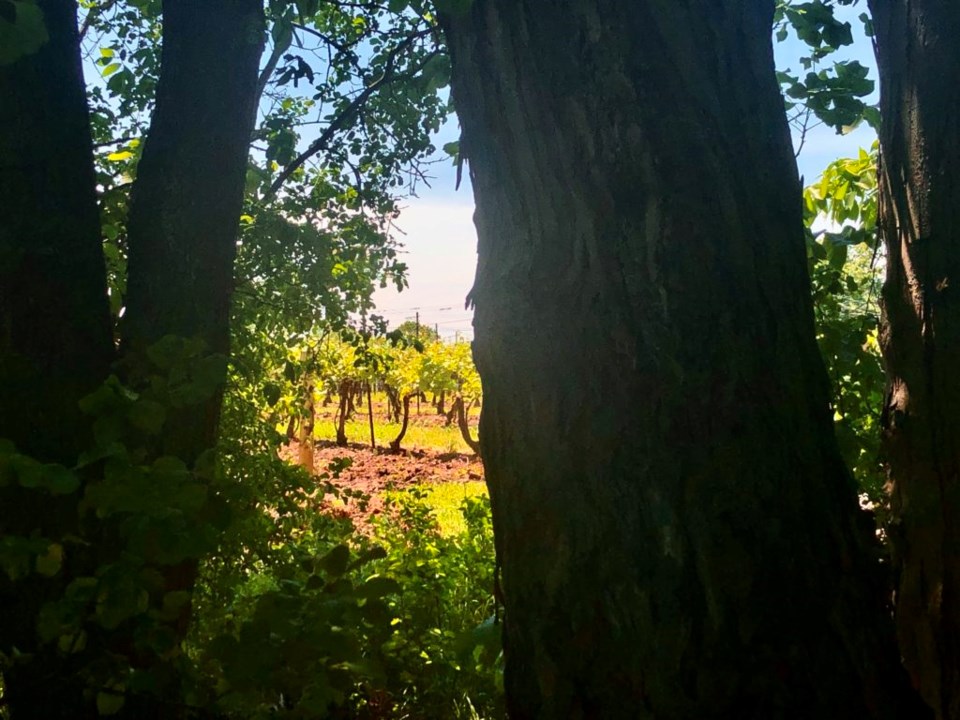
I often seek a change of scenery, and earlier this week, I found myself biking around through Virgil Conservation Area just to blow off some steam after a long day at the computer.
There are certainly more biodiverse and ecologically healthy conservation areas in Niagara other than Virgil, but that said, the ribbon of green meandering through an increasingly urban area is a designated important fish habitat, and a substantial wildlife corridor for deer, owls, and beavers along Four Mile Creek.
I’ve done it on foot, canoe, and bike. I have a recommendation on how to get the most out of this surprising local gem, no matter how you choose to access it. I just wouldn’t recommend swimming, unless you like mud and ear infections.
During my visit this week, I reminded myself of the classic art of stopping, sitting, and observing. At a murky and stagnant spot along the creek, I hopped off my bike and just sat on the boulder by the water for a while. While traffic whizzed by on Niagara Stone Road, the creek and forest came to life before my eyes. At first, the scene would appear bland, and that nobody was home. After a couple of minutes, fish started resurfacing and rippling the smooth surface. They become the most audibly and visually noticeable entity of the woods on a still day.
Then, a hummingbird zips in from out of nowhere, hovering in space and time before a blossom on a tree. I know hummingbirds dart around in town here, but it was nice to see one at home in a local conservation area.
A few minutes later, the ants have found their way up my legs, but these ones aren’t biters. I also find a couple of well-fed frogs positioned perfectly still on the bank next to me, laughing in stillness as I flick and pick the ants off.
A red-bellied woodpecker swoops in onto a dead tree limb overarching the creek. It allowed my biology brain to pause and note the holes in this chunk of wood, and the logs which have fallen and criss-crossed all over this bend in the stream. Great habitat complexity means great opportunities for residency.
Although a small area, it still provides enough of these key features to make it appreciable for local people and wildlife alike. I’ve thoroughly enjoyed seeing these creatures, plus snapping turtles, rainbow trout, black-crowned night herons, and coyotes of Four Mile Creek over the years.
Depending on my mood, I also like to rip through the trails as fast as I can on my mountain bike. Stepping it down, even just walking, you won’t be rewarded with the natural experiences the place can truly offer.
Sometimes, nature, and life in general, beckons us to stop, sit, and observe.
When our big biped bodies come walking and talking through the forest, the animals are already taking effortless cover before you even enter the treeline. You have an invisible sphere around you, and it’s bigger than you think.
Before you step into the woods, have fun imagining every animal out there slipping into a crack, hole, deeper in the mud, or running to the treetops. You are heard, seen, and your vibrations are felt coming from far away. No, that’s not hippy talk — reptiles, amphibians, and small mammals feel our footsteps in the soil before we even get there.
Sometimes, birds will sound the alarm first from their lofty perches. Deer, coyotes, foxes, and rabbits know these alarm calls in the blueprint, and they take the clue. They’ll go hide in the thorns, poison ivy, and tick-infested glades that we dare not venture into. It’s easy for them. As long as they have habitat and protected spaces, like here in Virgil.
On my own farm, I have taken a few hikes through ‘Tickville’ — the really overgrown grassy parts of the back acres. I have been blown away to find flattened vegetation mats, like crop circles, where deer have been resting. Some of these spots seem routinely used, close to a farm trail where horses and vehicles go by every day.
When I was hiking the Bruce Trail in 2014, I was alone for 99 per cent of it. This is where I discovered the power in stopping, pausing, and observing my surroundings, for several minutes. It was incredible to see what would literally crawl out of the trees, ground, or drop in from the sky once I froze. Frogs and birds think you’re gone for a minute, and they start to sing their songs. Snakes start to move across the dry leaves of the forest floor. Raccoons pop their heads out of tree cavities to look around again.
This is what happens out here 24/7, when humans aren’t stepping into the ecosystem’s space. I’ve done this in the wilderness woods of northern Ontario, the Amazon, and right here in Virgil. It gives the same results every time; you can see who truly lives there and who you’re sharing space with.
Depending where you are in the world, it can be a slippery slope into a terrifying experience if you imagine how many eyeballs are on you at once. I have chosen to see it as mysterious and comforting to know I’m surrounded by so much life. I’ve also wondered how many bears and jaguars have seen me, though.
If we slow down and observe, there is plenty of beauty hiding all around us at any moment. This also may unintentionally serve as a meditative experience, as we often forget to take time to just sit and relax with ourselves for a bit.
I’ll be doing more of the same in Niagara as the hot weather and strangely scheduled days continue.